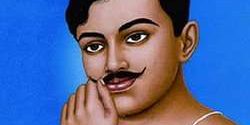 Chandra shekar Sitaram Tiwari, better known as Chandra shekar Azad (July 23, 1906, Bhavra – February 27, 1931, Allahabad) is one of the most important Indian revolutionaries, and is considered the mentor of Bhagat Singh.
Chandra shekar Sitaram Tiwari, better known as Chandra shekar Azad (July 23, 1906, Bhavra – February 27, 1931, Allahabad) is one of the most important Indian revolutionaries, and is considered the mentor of Bhagat Singh.
Early Life of Chandra shekar Azad
Chandra Shekar Azad was born on July 23,1906 in village Bhavra in Jhabua district of Madhya Pradesh. His parents were Pandit Sitaram Tiwari and Jagarani Devi. He received his early schooling in Bhavra. For higher studies he went to the Sanskrit Pathashala at Varanasi. He was an ardent follower of Hanuman and once disguised himself as a priest in a hanuman temple to escape the dragnet of British police. Chandra shekar Azad was deeply troubled by the Jallianwala Bagh massacre in Amritsar in 1919. In 1921, when Mahatma Gandhi launched the Non-Cooperation movement, he actively participated in the protest movement. He was arrested and received his first punishment at the age of fifteen for this act of civil disobedience. When the magistrate asked him his name, he said “Azad” (meaning free). For this, he was sentenced to fifteen lashes. With each stroke of the whip, young Chandrasekhar shouted “Bharat Mata Ki Jai”[“Hail The Motherland!”]. From that point onwards, Chandra shekar assumed the title of Azad and came to be known as Chandrashekhar Azad.
Revolutionary Activities and Execution
After suspension of the non-cooperation movement, Azad was attracted by more aggressive and violent revolutionary ideals. He committed himself to complete independence by any means. Towards this end, he formed the Hindustan Socialist Republican Association and was mentor to revolutionaries such as Bhagat Singh, Sukhdev, Batukeshwar Dutt, and Rajguru. HSRA’s goal was full Indian independence and wanted to build a new India based on socialist principles. Azad and his compatriots also planned and executed several acts of violence against the British. He was involved in numerous such activities like the Kakori Train Robbery (1925), the attempt to blow up the Viceroy’s train (1926), and the shooting of John Poyantz Saunders at Lahore (1928) to avenge the killing of Lala Lajpat Rai.
On february 27th, 1931 Chandra shekar Azad met two of his comrades at Alfred Park, Allahabad. He was recognised by a police, the police surrounded the park and ordered Chandra shekar Azad to surrender to them. Azad fought alone and killed three policemen but was shot in the thigh. After nearly exhausting his ammunition and foreseeing no means of escape, he shot himself in the head with his last bullet. Most of his revolutionary activities were planned and executed from Shahjahanpur.
Appalled by the brutal violence, Azad did not feel that violence was unacceptable in such a struggle, especially in view of the Jallianwala Bagh Massacre of 1919, when a British Army unit killed hundreds of unarmed civilians and wounded thousands in Amritsar. The Jallianwala Bagh Massacre deeply influenced young Azad and his contemporaries.
He once claimed that as his name was “Azad,” he would never be taken alive by police.(Not by Police most of Allahabad people told that a Hindi writer/journalist/press owner turned informer informed police about Azad )That is why he killed himself towards the end of a shootout with the police. Azad also believed that India’s future lay in socialism. Allegedly, he was aware of the informer who betrayed him to the police.
Azad was a very good friend of Pandit Ram Prasad Bismil & Jyoti Srivastavav. Azad and Vishwanath Gangadhar Vashampayan were the founding members, and pillars of HRA. Vishwanath was known as the right hand of Azad and he wrote the biography of Azad,which has many secret and valuable facts about revoloutionary movement.
The Hindustan Republican Association (HRA) was formed by Sachindranath Sanyal in 1923 after just one year of the Non co-operation movement. In the aftermath of the Kakori train robbery in 1925, the British clamped down on revolutionary activities. Sentenced to death for their participation were Pandit Ram Prasad Bismil, Ashfaqullah Khan, Thakur Roshan Singh and Rajendra Lahiri. Two escaped capture; one was Sunderlal Gupta and the other was Azad. Azad reorganized the HRA with the help of secondary revolutionaries like Shiva Varma and Mahaveer Singh. He was also an associate of Rasbihari Bose. Azad, along with Bhagat Singh, Sukhdev, and Rajguru, transformed the HRA into the HSRA (Hindustan Socialist Republican Association) in 1927, with the goal of complete Indian independence based on socialist principles.
Death
In 1931 Azad was living in Allahabad. On 27 February 1931, informer police spotted Azad and Sukhdevraj at Alfred Park discussing some plans and reported their presence to the police. Within a few minutes policemen surrounded the whole park. During the initial encounter, Azad suffered a bullet wound in his thigh, making it difficult for him to escape. But he made it possible for Sukhdev to escape by providing him covering fire. After Sukhdev escaped, Azad managed to keep the police at bay for a long time. Finally, with only one bullet left in his pistol and being completely surrounded and outnumbered, Chandra shekar Azad shot himself, keeping his pledge to never be captured alive. It is said that the Indian soldiers who saw him die did not approach his dead body for about two hours. He had always induced the guilt of Indian soldiers and policemen working for the British government, wherever he went, claiming that ‘they were not of true Indian blood’. The secret file related to Azad is preserved in C.I.D. Headquarters,1,Gokhale Marg,Lucknow. His COLT pistol is displayed at the Allahabad Museum along with some very rare photographs of his.





